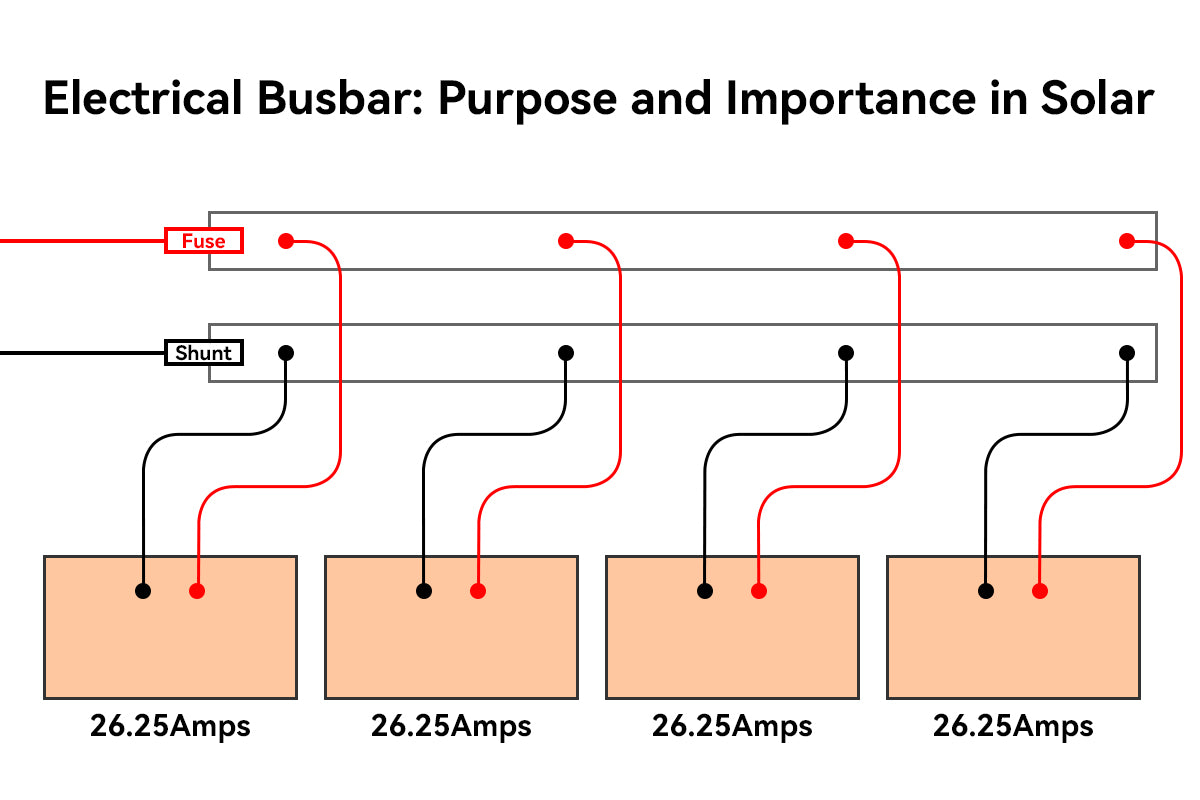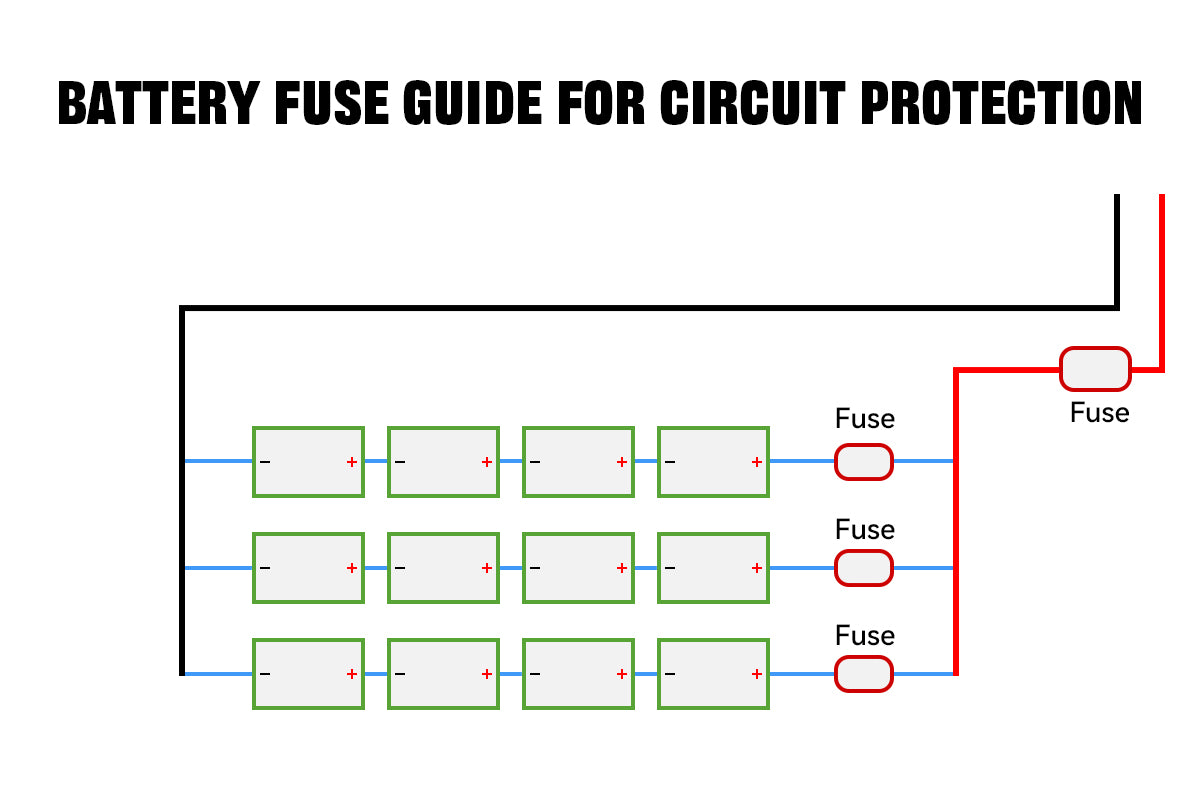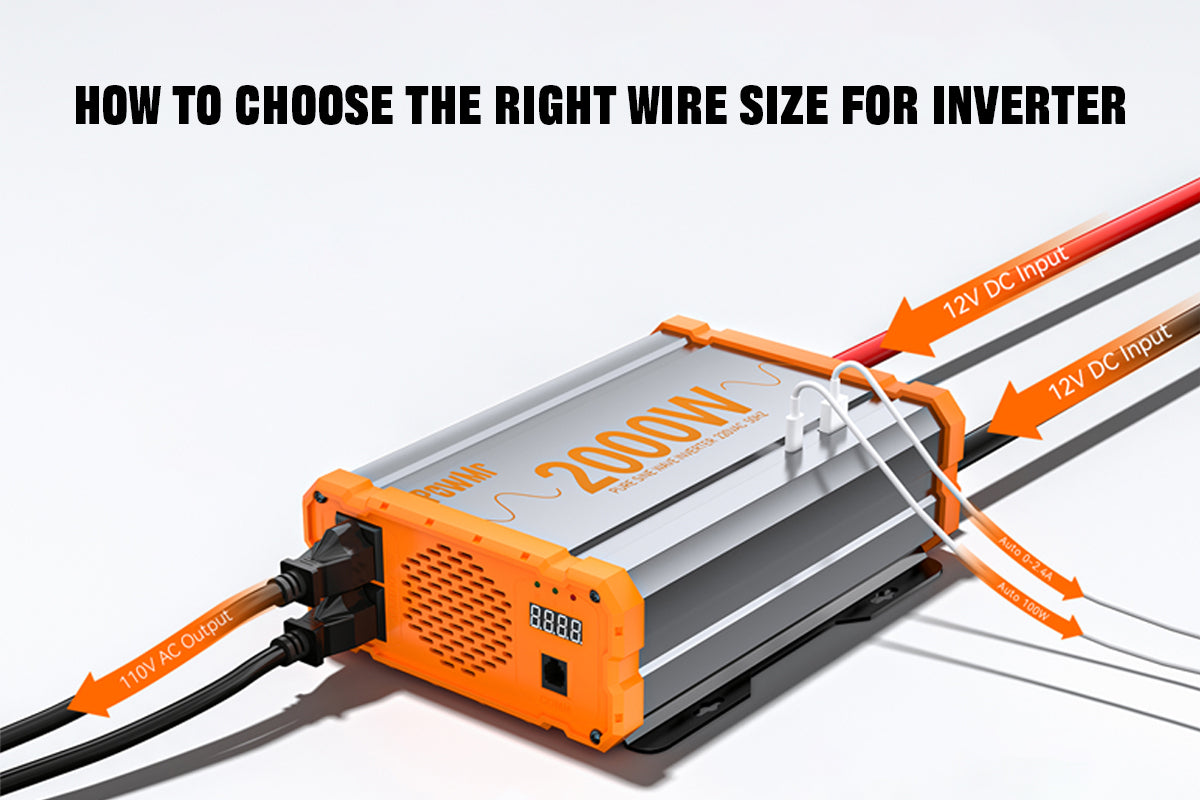In battery-powered solar energy systems, electrical busbars are often the unsung heroes. They quietly manage high currents, reduce wiring clutter, and ensure safe, efficient power distribution throughout the system. But what exactly is a busbar, why is it so important, and when should you use one?
In this article, we’ll explain everything you need to know about battery busbars, from their purpose and types to sizing, installation, and how to prevent failure.
What is electrical busbar
An electrical busbar is a solid metal conductor, usually made of copper or aluminum, designed to distribute electricity across multiple circuits or components. In battery systems, busbars replace bulky cables by centralizing all battery connections into one streamlined point.
A busbar can carry hundreds of amps when sized correctly, making it ideal for connecting multiple batteries in parallel, distributing power to inverters, chargers, and loads, while simplifying complex wiring setups.
Types of busbar
Copper busbar
Copper busbars offer excellent conductivity and are ideal for high-current applications. They're commonly used in solar battery banks and are often tin-plated to resist corrosion.
Aluminum Busbar
Aluminum busbars are lighter and more cost-effective than copper. However, they require a larger cross-sectional area to carry the same current and need surface treatment to prevent oxidation.
What is the primary purpose of busbar for battery
The primary purpose of a busbar in a battery system is to
A properly sized and installed busbar ensures that each battery charges and discharges at the same rate, extending overall battery life and improving system performance.
A battery busbar provide a low-resistance, high-conductivity path for balancing current flow during both charging and discharging cycles.

When you need a busbar for battery
Diagonal wiring is a common method to balance current when connecting up to two batteries in parallel. However, adding a third battery can already introduce imbalance, and once you reach four or more batteries, a busbar becomes the recommended solution.
As the number of batteries increases, so does the complexity of the wiring, which significantly raises the risk of uneven current flow. A busbar simplifies the layout and ensures that all batteries share the load evenly, improving both safety and performance.
How to size a busbar for battery
Theoretically, the size of a busbar depends on the maximum current that will flow through it. As a general rule, the busbar’s current-carrying capacity should be no less than the main wire ampacity (Inverter rated power ÷ Battery voltage ÷ Inverter efficiency × 1.25 + Fuse rating).
Note: Always follow the manufacturer’s recommendation unless unavailable. The 1.25 safety factor is based on NEC and may vary by country or local code.
Alternatively, it's acceptable to size the busbar based on the total discharge current of the battery system to allow flexibility for future expansion, since there should always be a fuse installed between the busbar and the charge controller or inverter to protect the wires.
In other words, you can use a busbar rated for 200A or more for two 100A batteries connected in parallel.
Related Article:
However, busbar sizing is not only about amperage. To ensure minimal resistance and safe thermal performance, other factors must be considered:
- Length: Longer busbars have higher resistance and voltage drop, so keep the length as short as possible.
- Width and Thickness: These dimensions directly affect the busbar’s cross-sectional area, influencing its current capacity and heat dissipation.
- Material: Copper offers better conductivity and requires less cross-sectional area than aluminum, though aluminum is lighter and often more cost-effective.
Why is a busbar used instead of wire
Using a busbar is recommended because it significantly optimizes system wiring, enhancing overall reliability and ease of maintenance. In parallel battery systems, the longer and more numerous the wires, the more complex the circuit becomes, increasing the likelihood of issues.
As current flows, the conductor’s temperature rises, causing changes in resistance. These dynamic variations not only reduce system efficiency but can also lead to potential risks such as overheating, voltage drop, and uneven discharge.
For paralleling batteries, the “daisy chain” configuration, where batteries are connected in series-parallel with long jumper cables, is poor battery connection.

In this setup, batteries closer to the charger or inverter experience less voltage drop, so they charge faster and discharge first, while the batteries further away lag behind.Over time, this imbalance leads to uneven wear and aging,reduced total usable capacity and increased risk of failure or overheating under load.
Even though diagonal wiring improves current balance compared to daisy chaining, it still causes imbalance in larger battery banks. There are typically two situations that occur:

1. End-position batteries often carry more current than middle batteries due to slight differences in wiring resistance. This leads to unequal charging or discharging, especially when the system is under load.
2. As current increases, the wires,especially those connected to the end batteries,begin to heat up. This rise in temperature further increases the wire’s resistance, which can worsen the imbalance. The batteries closest to the power source may become overloaded, while those in middle positions in the battery group still are underutilized.
This thermal-resistance feedback loop leads to uneven battery usage, faster degradation of certain batteries, and reduced overall efficiency.
With a busbar, each battery connects directly using equal-length, same-gauge cables, keeping resistance uniform. This ensures balanced charging and discharging, preventing any battery from being overworked or underused.
Advantages of busbar over cable
Electrical performance
Balanced energy distribution: By connecting each battery using equal-length cables to a centralized busbar, you ensure even current distribution, which prevents overload or underuse of specific battery units.
Higher system efficiency: Busbars reduce total resistance in the circuit, helping to lower voltage drop and heat loss, which increases overall system efficiency and extends battery life.
Greater current capacity: A properly sized copper or aluminum busbar can carry much higher current than an equivalently sized cable, making it ideal for high-power battery banks.
Greater surface area: Busbars provide a broad contact surface for connections, which reduces contact resistance and allows secure, and lowers the energy loss.
Wiring simplicity and flexibility
Easier Connections: A busbar allows you to easily tap into power at any point along its length, making wiring changes and system upgrades faster and more convenient.
Modular and scalable design: With a busbar, you can easily add or remove batteries, inverters, or loads without disrupting the entire setup, offering greater flexibility as your system grows.
Safety and maintenance
Cleaner, safer layout: Using a busbar helps organize wiring inside battery enclosures, minimizing clutter and reducing the risk of accidental shorts, loose connections, or cable overheating.
Simplified protection: Busbars make it easy to add fuses or breakers between each battery and the system, improving safety and making it easier to isolate faults or perform maintenance.
Improved monitoring capability: Shunts, voltage sensors, or BMS connections can be cleanly installed on a busbar, providing more accurate performance data and simplifying system diagnostics and monitoring.
Efficient heat dissipation: Thanks to its flat and exposed structure, a busbar dissipates heat more effectively than bundled cables, helping prevent localized overheating in high-current systems.
What happen if a busbar fails
A busbar failure in a battery system can have serious consequences, impacting both safety and system performance. Common failure modes include:
Overheating and melting: An undersized or loose busbar connection can generate excessive heat due to high resistance. This can melt the busbar or its insulation, causing electrical shorts or fires.
Voltage drop and power loss:If the busbar develops cracks, corrosion, or poor connections, it increases resistance. This results in voltage drops, reduced system efficiency, and uneven battery charging or discharging.
System instability: A damaged busbar disrupts current flow balance, leading to some batteries being overworked while others remain underutilized. This imbalance shortens battery life and can cause unpredictable system behavior.
Complete Power Failure: In severe cases, busbar failure can interrupt the entire power flow, causing outages or damage to connected equipment.
How to prevent busbar failure
Preventing busbar failure involves proper design, installation, and maintenance practices:
Correct sizing: Choose a busbar with adequate current capacity and cross-sectional area to handle peak loads and thermal stress.
Secure connections: Ensure all cable terminals and busbar connections are tight and properly torqued to prevent resistance buildup.
Quality materials: Use high-quality copper or aluminum busbars with proper plating (e.g., tin or nickel) to resist corrosion.
Proper insulation and clearance: Maintain safe spacing between positive and negative busbars and insulate exposed surfaces to prevent accidental shorts.
Regular inspection and maintenance: Periodically check for signs of overheating, discoloration, corrosion, or loosening of connections.
Adequate cooling: Ensure the busbar is installed in a well-ventilated area or includes cooling measures to dissipate heat effectively.



